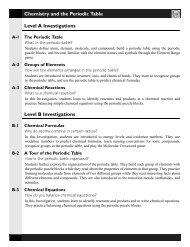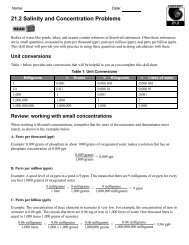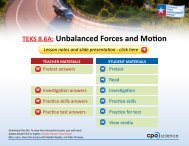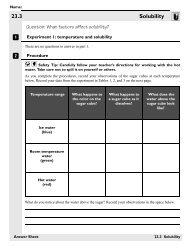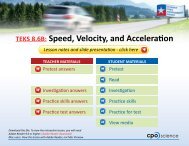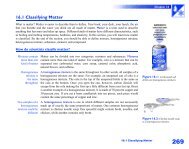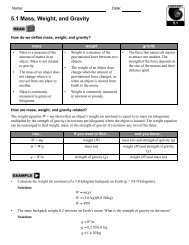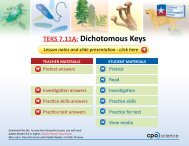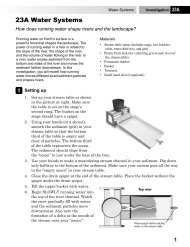22A Modeling a River - CPO Science
22A Modeling a River - CPO Science
22A Modeling a River - CPO Science
You also want an ePaper? Increase the reach of your titles
YUMPU automatically turns print PDFs into web optimized ePapers that Google loves.
<strong>Modeling</strong> a <strong>River</strong> Investigation <strong>22A</strong><strong>22A</strong> <strong>Modeling</strong> a <strong>River</strong>Which variables affect the formation of a river?When an experiment is done, usually one variable istested to see how it affects another variable. In thisinvestigation, you will learn about variables. You willmanipulate variables in an experiment that uses astream table.A stream table is a model of a river system. Youcannot easily change variables that affect a realriver. You can for a model river in a stream table!What variables might you be able to change? Youwill find out in this investigation.Materials• Stream table stage• Stream table• Bucket with spigot• Bucket without spigot• Displacement tank• Data Collector (optional)• WaterASetting up1. Fill the top 2/3 of the stream table withsand. Pour some water onto the sand andmix it all up so it is completely wet. Thesand should fill the tray up so it reaches justabout 2 centimeters below the edge of thetray.2. Smooth the surface of the sand out as muchas you can so it is nice and flat.3. Place the stream table on one of the rungsof the stand.4. Move the spigot on the bucket to the closedposition. Then, fill this bucket with water.Place it on top of the stage with the spigotpointing over the distribution trough thatchannels the water into the stream table.5. Place the empty bucket (the one withoutthe spigot) below the spigot of the streamtable to catch water that will run out ofthe tray once water starts to run into thetable.6. Make sure the spigot on the stream tableis in the closed position.1
Investigation<strong>22A</strong><strong>Modeling</strong> a <strong>River</strong>BLooking at a systemWhat is a system? A system is a group of objects and the variables that affect those objects.We’ll be looking at the stream table as a system. Examine the stream table setup with yourgroup and answer the following questions;a. What are the objects that make up the stream table?b. What are the variables that affect the objects in the system?c. What are some variables that probably do not affect the system?CDoing the activity1. Look at the lists of variables that affect the objects in the stream table system youmade in Part 2.2. With your group, observe how these variables affect the process of making a stream,and the final effects on the sand in the tray.3. Make sure your spigot at the bottom of the sand tray is closed. Place the bucketwithout the spigot under the spigot on the sand tray.4. Open the spigot on the bucket that is holding the water and let the water flow intothe trough, and down onto the stream table.5. Carefully observe what happens as the water flows onto the sand and down the tray.Make notes of your observations with your group.6. Close the spigot when your observations are over.7. If water gets to the point where it may spill over, open the spigot on the tray anddrain some water in the bucket below the spigot.D2More about variablesVariables are factors that affect a system. In Part 2 you listed variables that affected thestream table system. In Part 3, you made observations. You watched what happened, andmade notes about how you and your group thought the variables affected the system. In an
<strong>Modeling</strong> a <strong>River</strong> Investigation <strong>22A</strong>experiment, the investigator usually wants to see how one variable affects the system.Variables in an experiment can be categorized into independent variables, control variables,and dependent variables. These different types of variables are explained below.EPosing a scientific questionEvery experiment begins with a question:• How large is Earth?• How fast do mountains grow?• What is the best fertilizer for roses?• How old is this glacier?Asking questions helps to focus on what we want to know. Once we find out what it really isthat we want to know, we consider the possibilities based on what we have observed. Then, wemake a prediction about what we think is true. In science, this is called a hypothesis. Thepurpose of an experiment is to test if a hypothesis is true.1. Examine your list of variables you made in part 2, and your observations you made inPart 3.2. With your group, look at your list of variables and decide on a question that involvesthe formation of a stream in your tray and how changing one of those variables willchange the stream.3. There should be a cause and effect relationship between the variable and its effect onthe system. For example; Does making an object heavier make it fall to the groundfaster when it is dropped?4. What is your group’s question?3
Investigation<strong>22A</strong><strong>Modeling</strong> a <strong>River</strong>FHypothesis and variablesOnce you have your question formed, it is time to make a hypothesis about what you and yourgroup think will happen to your dependent variable when you change your independentvariable. Your hypothesis is a possible answer to this question.What is your question?Table 1: Your hypothesis, variables, and experimentWhat is your hypothesis?What is your independentvariable?What are your controlvariables?What is your dependentvariable?GDesigning your experimentIt is time to plan what you will do to test your hypothesis. This is what designing anexperiment is all about. Answer the questions below and present your proposal to your teacherfor final approval.a. What are you going to change about your independent variable?b. How will you measure and record this change? (Hint: make a data table)c. What are you going to measure concerning your dependent variable?4
d. How will you measure and record any change?<strong>Modeling</strong> a <strong>River</strong> Investigation <strong>22A</strong>e. What will you do to ensure your control variables remain the same?f. What is the procedure for your experiment?g. How will you know if your hypothesis is correct or not?HSetting up and performing your experimentOnce you have approval from your teacher, carefully follow your group’s plan and perform yourexperiment. Be sure to take notes about observations, things you may or should have donedifferently, or things you did well as your experiment is underway. Good luck!IEvaluating your dataa. Was your experiment able to answer your question?b. Did this experiment lead you to think of any other scientific questions? What are they?5
Investigation<strong>22A</strong><strong>Modeling</strong> a <strong>River</strong>c. What would you have done differently next time you design and perform an experiment?d. What was successful that you would try again in your next experiment?e. Can you present your data graphically, or in some other way that would help you tocommunicate your findings?J Conclusionsa. Was your hypothesis correct?b. If not, can you tell why it was not correct?c. Did you make any interesting observations that were not part of the original experiment?KPresenting your findingsAs time permits, gather your data together, make any graphs, charts, or diagrams that wouldbe helpful, and present your findings to your class as a group. All members should have somepart in the presentation. Write up a report that summarizes your experience.6



